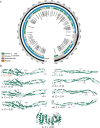Equine herpesvirus 4 infected domestic horses associated with Sintashta spoke-wheeled chariots around 4,000 years ago
- PMID: 38465241
- PMCID: PMC10924538
- DOI: 10.1093/ve/vead087
Equine herpesvirus 4 infected domestic horses associated with Sintashta spoke-wheeled chariots around 4,000 years ago
Abstract
Equine viral outbreaks have disrupted the socio-economic life of past human societies up until the late 19th century and continue to be of major concern to the horse industry today. With a seroprevalence of 60-80 per cent, equine herpesvirus 4 (EHV-4) is the most common horse pathogen on the planet. Yet, its evolutionary history remains understudied. Here, we screen the sequenced data of 264 archaeological horse remains to detect the presence of EHV-4. We recover the first ancient EHV-4 genome with 4.2× average depth-of-coverage from a specimen excavated in the Southeastern Urals and dated to the Early Bronze Age period, approximately 3,900 years ago. The recovery of an EHV-4 virus outside the upper respiratory tract not only points to an animal particularly infected but also highlights the importance of post-cranial bones in pathogen characterisation. Bayesian phylogenetic reconstruction provides a minimal time estimate for EHV-4 diversification to around 4,000 years ago, a time when modern domestic horses spread across the Central Asian steppes together with spoke-wheeled Sintashta chariots, or earlier. The analyses also considerably revise the diversification time of the two EHV-4 subclades from the 16th century based solely on modern data to nearly a thousand years ago. Our study paves the way for a robust reconstruction of the history of non-human pathogens and their impact on animal health.
Keywords: equine herpesvirus 4; horse; palaeogenomics; sintashta; virus evolution.
© The Author(s) 2024. Published by Oxford University Press.
Conflict of interest statement
None declared.
Figures



Similar articles
-
Immune horses rapidly increase antileukoproteinase and lack type I interferon secretion during mucosal innate immune responses against equine herpesvirus type 1.Microbiol Spectr. 2024 Oct 3;12(10):e0109224. doi: 10.1128/spectrum.01092-24. Epub 2024 Aug 20. Microbiol Spectr. 2024. PMID: 39162558 Free PMC article.
-
The origins and spread of domestic horses from the Western Eurasian steppes.Nature. 2021 Oct;598(7882):634-640. doi: 10.1038/s41586-021-04018-9. Epub 2021 Oct 20. Nature. 2021. PMID: 34671162 Free PMC article.
-
An Equine Herpesvirus Type 1 (EHV-1) Ab4 Open Reading Frame 2 Deletion Mutant Provides Immunity and Protection from EHV-1 Infection and Disease.J Virol. 2019 Oct 29;93(22):e01011-19. doi: 10.1128/JVI.01011-19. Print 2019 Nov 15. J Virol. 2019. PMID: 31462575 Free PMC article.
-
Contribution of the immune response to the pathogenesis of equine herpesvirus-1 (EHV-1): Are there immune correlates that predict increased risk or protection from EHV-1 myeloencephalopathy?Vet J. 2022 Apr;282:105827. doi: 10.1016/j.tvjl.2022.105827. Epub 2022 Apr 8. Vet J. 2022. PMID: 35405348 Review.
-
EHV-1: A Constant Threat to the Horse Industry.Front Microbiol. 2019 Dec 3;10:2668. doi: 10.3389/fmicb.2019.02668. eCollection 2019. Front Microbiol. 2019. PMID: 31849857 Free PMC article. Review.
Cited by
-
An Overview of Infectious and Non-Infectious Causes of Pregnancy Losses in Equine.Animals (Basel). 2024 Jul 2;14(13):1961. doi: 10.3390/ani14131961. Animals (Basel). 2024. PMID: 38998073 Free PMC article. Review.
-
Development and Preclinical Evaluation of a Lyophilized Vaccine Against Equine Herpesvirus Type 4 (EHV-4).Vaccines (Basel). 2025 May 31;13(6):604. doi: 10.3390/vaccines13060604. Vaccines (Basel). 2025. PMID: 40573935 Free PMC article.
-
Molecular and Serological Investigation of Equine Herpesvirus Type 1 (EHV-1) and Type 4 (EHV-4) in Horses In Ibagué, Tolima.Vet Med Int. 2025 Jan 29;2025:1661949. doi: 10.1155/vmi/1661949. eCollection 2025. Vet Med Int. 2025. PMID: 39949613 Free PMC article.
References
-
- Allen G. P., and Bryans J. T. (1986) ‘Molecular Epizootiology, Pathogenesis, and Prophylaxis of Equine Herpesvirus-1 Infections’, Progress in Veterinary Microbiology and Immunology, 2: 78–144. - PubMed
-
- Allentoft M. E. et al. (2015) ‘Population Genomics of Bronze Age Eurasia’, Nature, 522: 167–72. - PubMed
-
- Anthony D. W. (2007) The Horse, the Wheel, and Language: How Bronze-Age Riders from the Eurasian Steppes Shaped the Modern World. Princeton University Press: Princeton, NJ, USA.
-
- ——— (2009) ‘The Sintashta Genesis: The Roles of Climate Change, Warfare, and Long-Distance Trade’, in Hanks, B. K., and Linduff, K. M. (eds) Social Complexity in Prehistoric Eurasia. Monuments, Metals, and Mobility. New York, NY, USA: Cambridge University Press, pp. 47–73
LinkOut - more resources
Full Text Sources
Miscellaneous

